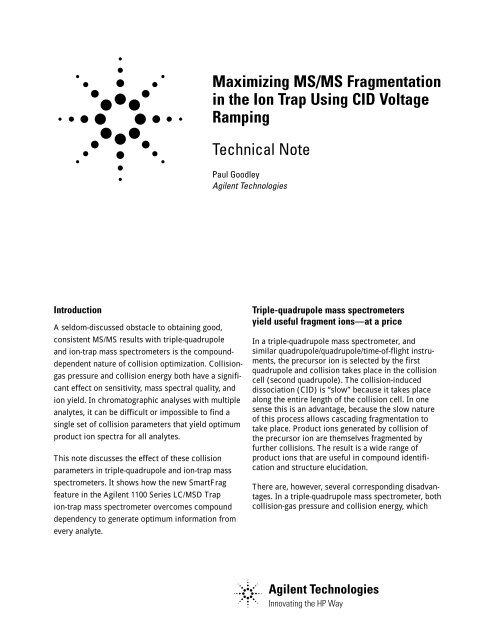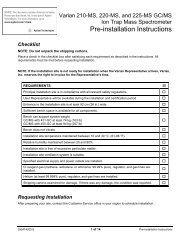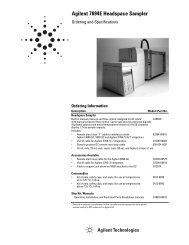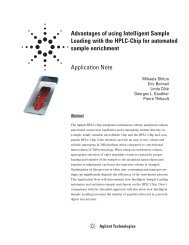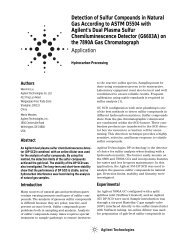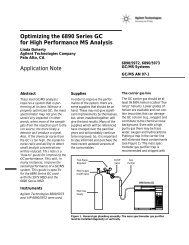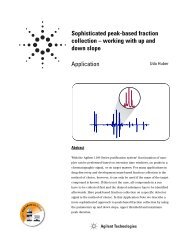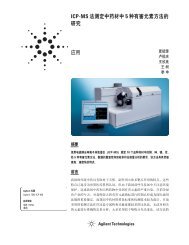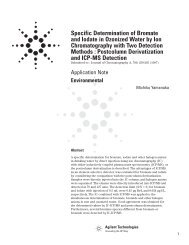Maximizing MS/MS Fragmentation in the Ion Trap Using CID Voltage ...
Maximizing MS/MS Fragmentation in the Ion Trap Using CID Voltage ...
Maximizing MS/MS Fragmentation in the Ion Trap Using CID Voltage ...
You also want an ePaper? Increase the reach of your titles
YUMPU automatically turns print PDFs into web optimized ePapers that Google loves.
<strong>Maximiz<strong>in</strong>g</strong> <strong>MS</strong>/<strong>MS</strong> <strong>Fragmentation</strong><strong>in</strong> <strong>the</strong> <strong>Ion</strong> <strong>Trap</strong> Us<strong>in</strong>g <strong>CID</strong> <strong>Voltage</strong>Ramp<strong>in</strong>gTechnical NotePaul GoodleyAgilent TechnologiesIntroductionA seldom-discussed obstacle to obta<strong>in</strong><strong>in</strong>g good,consistent <strong>MS</strong>/<strong>MS</strong> results with triple-quadrupoleand ion-trap mass spectrometers is <strong>the</strong> compounddependentnature of collision optimization. Collisiongaspressure and collision energy both have a significanteffect on sensitivity, mass spectral quality, andion yield. In chromatographic analyses with multipleanalytes, it can be difficult or impossible to f<strong>in</strong>d as<strong>in</strong>gle set of collision parameters that yield optimumproduct ion spectra for all analytes.This note discusses <strong>the</strong> effect of <strong>the</strong>se collisionparameters <strong>in</strong> triple-quadrupole and ion-trap massspectrometers. It shows how <strong>the</strong> new SmartFragfeature <strong>in</strong> <strong>the</strong> Agilent 1100 Series LC/<strong>MS</strong>D <strong>Trap</strong>ion-trap mass spectrometer overcomes compounddependency to generate optimum <strong>in</strong>formation fromevery analyte.Triple-quadrupole mass spectrometersyield useful fragment ions—at a priceIn a triple-quadrupole mass spectrometer, andsimilar quadrupole/quadrupole/time-of-flight <strong>in</strong>struments,<strong>the</strong> precursor ion is selected by <strong>the</strong> firstquadrupole and collision takes place <strong>in</strong> <strong>the</strong> collisioncell (second quadrupole). The collision-<strong>in</strong>duceddissociation (<strong>CID</strong>) is “slow” because it takes placealong <strong>the</strong> entire length of <strong>the</strong> collision cell. In onesense this is an advantage, because <strong>the</strong> slow natureof this process allows cascad<strong>in</strong>g fragmentation totake place. Product ions generated by collision of<strong>the</strong> precursor ion are <strong>the</strong>mselves fragmented byfur<strong>the</strong>r collisions. The result is a wide range ofproduct ions that are useful <strong>in</strong> compound identificationand structure elucidation.There are, however, several correspond<strong>in</strong>g disadvantages.In a triple-quadrupole mass spectrometer, bothcollision-gas pressure and collision energy, which
<strong>Maximiz<strong>in</strong>g</strong> <strong>MS</strong>/<strong>MS</strong> <strong>Fragmentation</strong> <strong>in</strong> <strong>the</strong> <strong>Ion</strong> <strong>Trap</strong> Us<strong>in</strong>g <strong>CID</strong> <strong>Voltage</strong> Ramp<strong>in</strong>gAgilent Technologiesis controlled by <strong>the</strong> collision-cell voltage, havesignificant effects on analytical results. Both mustbe optimized <strong>in</strong> order to achieve <strong>the</strong> best analyticalresults. Because optimum sett<strong>in</strong>gs are compounddependent, sett<strong>in</strong>gs that produce good results for<strong>the</strong> first compound to elute may yield poor resultsfor <strong>the</strong> next compound. A triple-quadrupole massspectrometer must be able to change sett<strong>in</strong>gs foreach analyte to produce optimum results.Traditional ion traps havea different set of challengesThe ion trap works somewhat differently. Theprecursor ions are held near <strong>the</strong> center of <strong>the</strong> trap<strong>in</strong> a conf<strong>in</strong>ed space. The collision time tends to beshorter (faster), allow<strong>in</strong>g little or no time for fur<strong>the</strong>rfragmentation of <strong>the</strong> product ions. The result isfewer product ions and less structural <strong>in</strong>formation.Traditionally, this was compensated for by us<strong>in</strong>g<strong>the</strong> ion trap’s ability to perform more levels of<strong>MS</strong> analysis to cont<strong>in</strong>ue select<strong>in</strong>g and fragment<strong>in</strong>gproduct ions. Indeed, this is a very powerfultechnique that allows structure to be determ<strong>in</strong>ed<strong>in</strong> a very controlled fashion. Recent <strong>in</strong>novations,however, allow <strong>the</strong> Agilent ion trap to generatemore structural <strong>in</strong>formation with fewer steps of<strong>MS</strong> and at <strong>the</strong> same time overcome <strong>the</strong> compounddependentnature of collision optimization.In <strong>the</strong> ion trap, <strong>the</strong> collision gas, generally helium,reduces <strong>the</strong> k<strong>in</strong>etic energy of <strong>the</strong> <strong>in</strong>com<strong>in</strong>g ions as<strong>the</strong>y approach <strong>the</strong> center of <strong>the</strong> trap. The amountof gas <strong>in</strong> <strong>the</strong> trap is generally fixed and is notchanged for different compounds. This leaves onevariable, collision energy, with a significant andcompound-dependent <strong>in</strong>fluence over fragmentation.<strong>CID</strong> voltage ramp<strong>in</strong>g <strong>in</strong> <strong>the</strong> ion trapprovides <strong>the</strong> best of both worldsA new feature, <strong>CID</strong> voltage ramp<strong>in</strong>g (SmartFrag),is built <strong>in</strong>to firmware of <strong>the</strong> Agilent 1100 SeriesLC/<strong>MS</strong>D <strong>Trap</strong>. <strong>CID</strong> voltage ramp<strong>in</strong>g elim<strong>in</strong>ates <strong>the</strong>need to optimize <strong>the</strong> collision energy for differentcompounds. Each time <strong>MS</strong>/<strong>MS</strong> is performed, <strong>CID</strong>voltage ramp<strong>in</strong>g quickly ramps <strong>the</strong> collision voltageover a range of energies. This ensures that eachcompound receives <strong>the</strong> correct energy for optimumfragmentation. It also results <strong>in</strong> a higher level offragmentation, provid<strong>in</strong>g more structural <strong>in</strong>formationwith fewer steps of <strong>MS</strong>/<strong>MS</strong>.Figure 1a shows <strong>the</strong> full-scan mass spectrumof prednisone, an anti-<strong>in</strong>flammatory steroid hav<strong>in</strong>ga protonated molecular ion [M+H] + at m/z 359.Figure 1b depicts <strong>the</strong> <strong>MS</strong>/<strong>MS</strong> full-scan spectrumobta<strong>in</strong>ed at a fixed collision energy of 0.8v. The<strong>MS</strong>/<strong>MS</strong> spectrum yields a large precusor ion anda few product ions which show m/z losses for awater molecule and for a water molecule and CO(total of 46). Figure 1c shows <strong>the</strong> same <strong>MS</strong>/<strong>MS</strong>full-scan spectrum obta<strong>in</strong>ed us<strong>in</strong>g <strong>the</strong> <strong>CID</strong> voltageramp<strong>in</strong>g. The spectrum is rich with product ionsprovid<strong>in</strong>g much structural <strong>in</strong>formation.2
<strong>Maximiz<strong>in</strong>g</strong> <strong>MS</strong>/<strong>MS</strong> <strong>Fragmentation</strong> <strong>in</strong> <strong>the</strong> <strong>Ion</strong> <strong>Trap</strong> Us<strong>in</strong>g <strong>CID</strong> <strong>Voltage</strong> Ramp<strong>in</strong>gAgilent TechnologiesIntens× 10 6 <strong>Ion</strong>-<strong>Trap</strong> Full-Scan <strong>MS</strong> of1.5 Prednisone; Molecular <strong>Ion</strong>at m/z 359OCH 3CH 2 OHCH 3OOH+ All <strong>MS</strong>, 3.0 m<strong>in</strong> (#2)359.11.0O[M + H] +a0.50.0200 220 240 260 280 300 320 340 360m/zIntens+ <strong>MS</strong>/<strong>MS</strong> (359), 0.9 m<strong>in</strong> (#46)× 10 6 Full-Scan <strong>CID</strong> <strong>MS</strong>/<strong>MS</strong> ofO359.1m/z 359; Non-rampedCH 2 OHCH 31.0 <strong>CID</strong> <strong>Voltage</strong>OOH0.8CH 30.6O0.40.2313.2341.10.0200 220 240 260 280 300 320 340 360 m/z×Intens10 52.5+ <strong>MS</strong>/<strong>MS</strong> (359), 1.3 m<strong>in</strong> (#5)Full-Scan <strong>CID</strong> <strong>MS</strong>/<strong>MS</strong> ofO CH 2 OH341.1CHm/z 359; us<strong>in</strong>g Ramped3OOH<strong>CID</strong> <strong>Voltage</strong>CH 32.0313.01.5O323.0295.01.0305.00.5212.9267.0186.9237.1 253.1 277.0287.00.0200 220 240 260 280 300 320 340 360 m/z[M + H – 46] +[M + H – 2 (H 2 0)] +[M + H – H 2 0] +[M + H – H 2 0] +[M + H] +bcFigure 1. <strong>MS</strong>/<strong>MS</strong> of Prednisone us<strong>in</strong>g <strong>CID</strong> voltage ramp<strong>in</strong>g3
<strong>Maximiz<strong>in</strong>g</strong> <strong>MS</strong>/<strong>MS</strong> <strong>Fragmentation</strong> <strong>in</strong> <strong>the</strong> <strong>Ion</strong> <strong>Trap</strong> Us<strong>in</strong>g <strong>CID</strong> <strong>Voltage</strong> Ramp<strong>in</strong>gAgilent TechnologiesFigure 2a is a full-scan mass spectrum of <strong>the</strong>antihypertensive, Labetalol, hav<strong>in</strong>g a protonatedmolecular ion at m/z 329. Figure 2b shows <strong>MS</strong>/<strong>MS</strong>of <strong>the</strong> precursor ion yield<strong>in</strong>g a major ion at m/z 311,which corresponds to <strong>the</strong> loss of a water molecule.The spectrum is nearly bare of product ions, present<strong>in</strong>g<strong>the</strong> need for more stages of <strong>MS</strong> to more fullyconfirm <strong>the</strong> molecular structure. If this occurs witha triple-quadrupole system, <strong>the</strong> option for <strong>MS</strong> 3 doesnot exist and o<strong>the</strong>r confirmatory approaches may beneeded. Figure 2c shows <strong>MS</strong>/<strong>MS</strong> of Labetalol us<strong>in</strong>g<strong>CID</strong> voltage ramp<strong>in</strong>g. The full-scan <strong>MS</strong>/<strong>MS</strong> production spectrum is rich with product ions and <strong>the</strong> mostabundant ion <strong>in</strong> <strong>the</strong> spectrum is at m/z 207. Thisprovides much more structural <strong>in</strong>formation than <strong>the</strong>s<strong>in</strong>gle ion at m/z 311.Intens× 10 5 <strong>Ion</strong>-<strong>Trap</strong> Full-Scan <strong>MS</strong>Yields Molecular <strong>Ion</strong>6 at m/z 3294H 2 NHOOOHHNCH 3+ All <strong>MS</strong>, 1.4 m<strong>in</strong> (#54)329.2[M + H] +a2Labetalol0100 125 150 175 200 225 250 275 300 325 m/zIntens× 10 51.51.00.50.0Intens× 10 43210Classical <strong>Ion</strong> <strong>Trap</strong> Without<strong>CID</strong> <strong>Voltage</strong> Ramp<strong>in</strong>gFull-Scan <strong>CID</strong> <strong>MS</strong>/<strong>MS</strong>OYields Major <strong>Ion</strong>Has Loss of Water2 Nat m/z 311HOFull-Scan <strong>CID</strong> <strong>MS</strong>/<strong>MS</strong>of m/z 329 us<strong>in</strong>g <strong>CID</strong><strong>Voltage</strong> Ramp<strong>in</strong>g147.1162.1179.1190.1207.1207.1H 2 N100 125 150 175 200 225 250 275 300 325 m/zHOOOHHN266.1+ <strong>MS</strong>/<strong>MS</strong> (329/311), 2.9 m<strong>in</strong> (#84)311.2100 125 150 175 200 225 250 275 300 325 m/zOHHNCH 3CH 3294.2+ <strong>MS</strong>/<strong>MS</strong> (329/311), 3.3 m<strong>in</strong>294.2[M + H – H 2 0] +311.2[M + H – H 2 0] +bcFigure 2. <strong>MS</strong>/<strong>MS</strong> of Labetalol us<strong>in</strong>g <strong>CID</strong> voltage ramp<strong>in</strong>g4
<strong>Maximiz<strong>in</strong>g</strong> <strong>MS</strong>/<strong>MS</strong> <strong>Fragmentation</strong> <strong>in</strong> <strong>the</strong> <strong>Ion</strong> <strong>Trap</strong> Us<strong>in</strong>g <strong>CID</strong> <strong>Voltage</strong> Ramp<strong>in</strong>gAgilent TechnologiesFigure 3 is ano<strong>the</strong>r example of <strong>the</strong> use of <strong>CID</strong>voltage ramp<strong>in</strong>g. Figure 3a is <strong>the</strong> full-scan massspectrum of 4-hydroxytamoxifen, a compound for<strong>the</strong> treatment of breast cancer. Figure 3b showsresult of <strong>MS</strong>/<strong>MS</strong> of tamoxifen at a fixed collisionvoltage of 0.9 V. Although <strong>the</strong> spectrum yields sixto seven ions useful for structural characterization,<strong>the</strong> precusor ion is not totally fragmented. Fur<strong>the</strong>ranalysis would be required to f<strong>in</strong>d <strong>the</strong> optimum<strong>CID</strong> voltage to obta<strong>in</strong> a more spectral-rich production spectrum. Without o<strong>the</strong>r experimental changes,switch<strong>in</strong>g to <strong>CID</strong> voltage ramp<strong>in</strong>g generated <strong>the</strong>product ion spectrum shown <strong>in</strong> Figure 3c.Intens× 10 6 <strong>Ion</strong>-<strong>Trap</strong> Full-Scan <strong>MS</strong>5 Yields Molecular <strong>Ion</strong>at m/z 388432CH 3OHONCH 3CH 3+ <strong>MS</strong>/<strong>MS</strong> (388), 0.8 m<strong>in</strong>388.2[M + H] +a14-Hydroxytamoxifen03210100 150 200 250 300 350 400 m/zIntens× 10 5 Full-Scan <strong>CID</strong> <strong>MS</strong>/<strong>MS</strong>4 of m/z 388; Non-ramped<strong>CID</strong> voltage128.9 144.9166.1209.1223.1249.1+ <strong>MS</strong>/<strong>MS</strong> (388), 5.3 m<strong>in</strong>100 150 200 250 300 350 400 m/zFull-Scan <strong>CID</strong> <strong>MS</strong>/<strong>MS</strong>Intens of m/z 388 us<strong>in</strong>g <strong>CID</strong>× 10 4 <strong>Voltage</strong> Ramp<strong>in</strong>g3210166.1183.1223.1CH 3128.9 145.0249.1194.1OHCH 3265.1287.1OOH287.1 301.2100 150 200 250 300 350 400 m/zN316.2316.2CH 3CH 3343.2O343.2[M + H – 45] +NCH 3CH 3388.2[M + H] ++ <strong>MS</strong>/<strong>MS</strong> (388), 2.5 m<strong>in</strong>[M + H – 45] +bcFigure 3. <strong>MS</strong>/<strong>MS</strong> of 4-hydroxytamoxifen us<strong>in</strong>g <strong>CID</strong> voltage ramp<strong>in</strong>g5
<strong>Maximiz<strong>in</strong>g</strong> <strong>MS</strong>/<strong>MS</strong> <strong>Fragmentation</strong> <strong>in</strong> <strong>the</strong> <strong>Ion</strong> <strong>Trap</strong> Us<strong>in</strong>g <strong>CID</strong> <strong>Voltage</strong> Ramp<strong>in</strong>gAgilent TechnologiesConclusionsUs<strong>in</strong>g <strong>the</strong> <strong>CID</strong> voltage ramp<strong>in</strong>g feature of <strong>the</strong>Agilent LC/<strong>MS</strong>D <strong>Trap</strong> ion-trap mass spectrometerelim<strong>in</strong>ates <strong>the</strong> need for time-consum<strong>in</strong>g collisionvoltageoptimization. By sett<strong>in</strong>g a range of <strong>CID</strong>voltages us<strong>in</strong>g <strong>the</strong> SmartFrag sett<strong>in</strong>g, an analystcan be certa<strong>in</strong> to obta<strong>in</strong> fragment-rich, full-scanproduct-ion spectra for identity confirmation orstructure elucidation.For more <strong>in</strong>formation on our products and services, you can visit our siteon <strong>the</strong> World Wide Web at: http://www.agilent.com/chemAgilent Technologies shall not be liable for errors conta<strong>in</strong>ed here<strong>in</strong> or for<strong>in</strong>cidental or consequential damages <strong>in</strong> connection with <strong>the</strong> furnish<strong>in</strong>g,performance or use of this material.Information, descriptions and specifications <strong>in</strong> this publication aresubject to change without notice.Copyright © 2000Agilent TechnologiesAll rights reserved.Reproduction and adaptation is prohibited.Pr<strong>in</strong>ted <strong>in</strong> <strong>the</strong> U.S.A. November 2000(23) 5988-0704EN


